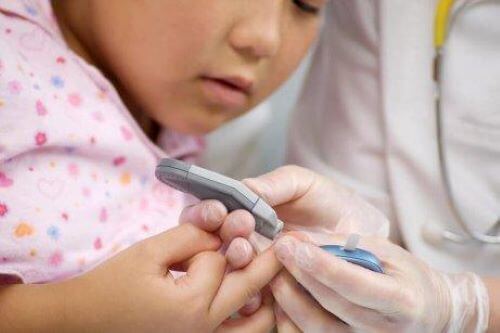Juvenile Diabetes: Learn the Signs

Juvenile diabetes is a disease that continues to increase significantly from year to year. It has spread considerably around the world, increasing from 5% to 10% of the world’s population, according to the World Health Organization.
The disease is caused when the body doesn’t produce a sufficient amount of a hormone called insulin. Children with diabetes follow special treatment regimens to replace the needed insulin.
The procedures associated with managing diabetes can be uncomfortable for children. Depending on their age, they have to learn to give themselves insulin injections.
Children with diabetes also have to know how to test their own blood sugar levels and keep track of their carbohydrate consumption with a special machine.
Managing juvenile diabetes requires constant monitoring and control. Fortunately, technological advances have greatly improved how insulin is administered and how blood sugar levels are controlled.
This has brought better treatments and improved the quality of life for patients who suffer from this condition.
The signs of juvenile diabetes
Symptoms
In general, the symptoms of diabetes in children manifests quickly; it can appear in just days, or sometimes over the course of a few weeks. Some of the symptoms can include the following:
Increased urge to urinate. Large quantities of sugar accumulate in the child’s bloodstream, causing the child to feel very thirsty. As a result, the child will consume more liquids with an increased urge to go to the bathroom. This also makes it likely that small children with diabetes may wet the bed.
Bigger appetite. With little insulin circulating to help move blood sugar, it’s very likely that the organs and muscles will lack sufficient energy, triggering an increase in appetite in their body.
Weight loss. One of the first symptoms of childhood diabetes is weight loss. This disease causes greater appetite and the child eats more than usual. But without the necessary sugar to produce energy, the muscular tissues will start burning the body’s fat reserves.
Fatigue or lack of energy. Because there is insufficient sugar in the body, you’ll notice the child constantly feels tired.

Behavioral changes. Mood swings are a constant problem in children with this condition. It’s very common that their mood changes frequently, from being exuberant and happy to sullen and depressed. In addition, they might even become mostly agitated and angry.
Breath that smells fruity. By burning fat instead of sugar, the result is the creation of certain substances called ketone bodies, causing a fruity smell on the breath.
Blindness or blurry vision. It’s likely that the disease causes blindness. Having high levels of sugar in the blood can affect the crystalline liquid in the eyes.
Candidiasis. Especially in girls who have diabetes, it’s very likely they have genital candidiasis.
Causes of juvenile diabetes
There isn’t a precise cause of childhood diabetes, but in most cases of Type 1 diabetes, it seems to be linked to the immune system of the body that combats viruses and bacterias. In the case of Type 1 diabetes, the immune system also destroys the cells of the pancreas, which is what produces insulin.
Insulin is responsible for transporting sugar (glucose) around the bloodstream to the whole body. Generally, sugar enters the bloodstream by ingesting food. However, when the isolates of the pancreas are destroyed, the child produces low levels of insulin.
The consequence is the accumulation of glucose in the bloodstream. Unfortunately, this can cause problems that can put the child’s life at risk.
Prevention
Currently, there is no solution or cure to prevent Type 1 diabetes. However, there have been many analyses to determine if there is a link between children who possess certain antibodies and diabetes. Yet the presence of the antibodies doesn’t mean that diabetes is inevitable.
Scientists are in a constant search to prevent childhood diabetes in children who are at high risk of suffering from this condition. Furthermore, other scientists are focusing on research into ways to avoid the destruction of the isolates of the pancreas in patients who have been diagnosed.

For now, there is nothing that can be done to reverse a diagnosis of Type 1 childhood diabetes, but it’s possible to follow a number of guidelines that will help avoid further complications:
- Help maintain good control of blood sugar levels.
- Teach the importance of having a healthy and balanced diet along with regular exercise.
- Visit the doctor regularly to control the child’s condition. It’s recommended that children with this condition visit the doctor at least annually and more so if close monitoring is needed.
“As the child grows, it’s fundamental that they learn good habits that will help them to adequately manage their condition.”
In sum, it’s important to be aware of the symptoms to be able to take action should any incidents or problems with juvenile diabetes arise.
Juvenile diabetes is a disease that continues to increase significantly from year to year. It has spread considerably around the world, increasing from 5% to 10% of the world’s population, according to the World Health Organization.
The disease is caused when the body doesn’t produce a sufficient amount of a hormone called insulin. Children with diabetes follow special treatment regimens to replace the needed insulin.
The procedures associated with managing diabetes can be uncomfortable for children. Depending on their age, they have to learn to give themselves insulin injections.
Children with diabetes also have to know how to test their own blood sugar levels and keep track of their carbohydrate consumption with a special machine.
Managing juvenile diabetes requires constant monitoring and control. Fortunately, technological advances have greatly improved how insulin is administered and how blood sugar levels are controlled.
This has brought better treatments and improved the quality of life for patients who suffer from this condition.
The signs of juvenile diabetes
Symptoms
In general, the symptoms of diabetes in children manifests quickly; it can appear in just days, or sometimes over the course of a few weeks. Some of the symptoms can include the following:
Increased urge to urinate. Large quantities of sugar accumulate in the child’s bloodstream, causing the child to feel very thirsty. As a result, the child will consume more liquids with an increased urge to go to the bathroom. This also makes it likely that small children with diabetes may wet the bed.
Bigger appetite. With little insulin circulating to help move blood sugar, it’s very likely that the organs and muscles will lack sufficient energy, triggering an increase in appetite in their body.
Weight loss. One of the first symptoms of childhood diabetes is weight loss. This disease causes greater appetite and the child eats more than usual. But without the necessary sugar to produce energy, the muscular tissues will start burning the body’s fat reserves.
Fatigue or lack of energy. Because there is insufficient sugar in the body, you’ll notice the child constantly feels tired.

Behavioral changes. Mood swings are a constant problem in children with this condition. It’s very common that their mood changes frequently, from being exuberant and happy to sullen and depressed. In addition, they might even become mostly agitated and angry.
Breath that smells fruity. By burning fat instead of sugar, the result is the creation of certain substances called ketone bodies, causing a fruity smell on the breath.
Blindness or blurry vision. It’s likely that the disease causes blindness. Having high levels of sugar in the blood can affect the crystalline liquid in the eyes.
Candidiasis. Especially in girls who have diabetes, it’s very likely they have genital candidiasis.
Causes of juvenile diabetes
There isn’t a precise cause of childhood diabetes, but in most cases of Type 1 diabetes, it seems to be linked to the immune system of the body that combats viruses and bacterias. In the case of Type 1 diabetes, the immune system also destroys the cells of the pancreas, which is what produces insulin.
Insulin is responsible for transporting sugar (glucose) around the bloodstream to the whole body. Generally, sugar enters the bloodstream by ingesting food. However, when the isolates of the pancreas are destroyed, the child produces low levels of insulin.
The consequence is the accumulation of glucose in the bloodstream. Unfortunately, this can cause problems that can put the child’s life at risk.
Prevention
Currently, there is no solution or cure to prevent Type 1 diabetes. However, there have been many analyses to determine if there is a link between children who possess certain antibodies and diabetes. Yet the presence of the antibodies doesn’t mean that diabetes is inevitable.
Scientists are in a constant search to prevent childhood diabetes in children who are at high risk of suffering from this condition. Furthermore, other scientists are focusing on research into ways to avoid the destruction of the isolates of the pancreas in patients who have been diagnosed.

For now, there is nothing that can be done to reverse a diagnosis of Type 1 childhood diabetes, but it’s possible to follow a number of guidelines that will help avoid further complications:
- Help maintain good control of blood sugar levels.
- Teach the importance of having a healthy and balanced diet along with regular exercise.
- Visit the doctor regularly to control the child’s condition. It’s recommended that children with this condition visit the doctor at least annually and more so if close monitoring is needed.
“As the child grows, it’s fundamental that they learn good habits that will help them to adequately manage their condition.”
In sum, it’s important to be aware of the symptoms to be able to take action should any incidents or problems with juvenile diabetes arise.
All cited sources were thoroughly reviewed by our team to ensure their quality, reliability, currency, and validity. The bibliography of this article was considered reliable and of academic or scientific accuracy.
- Dra. Sara J. Carlson. (2017). Diabetes tipo 1 en niños. Mayo Clinic.
- Organización Mundial de la Salud. (2016). Informe mundial sobre la diabetes.
This text is provided for informational purposes only and does not replace consultation with a professional. If in doubt, consult your specialist.








